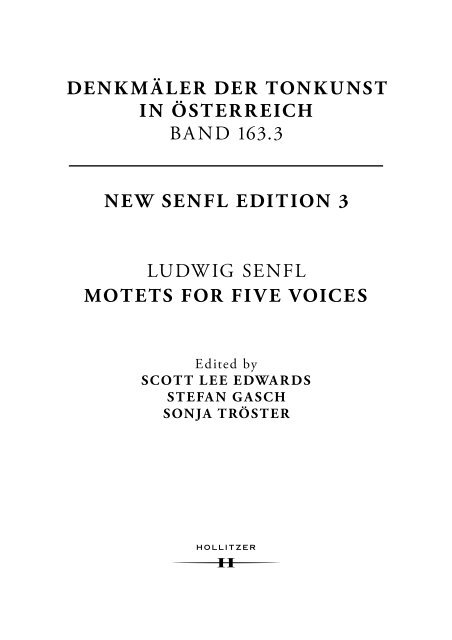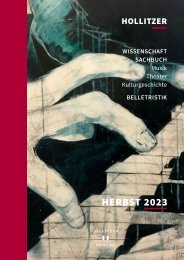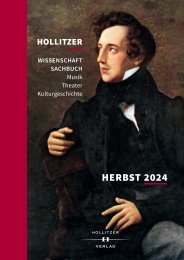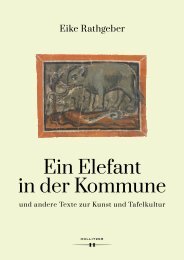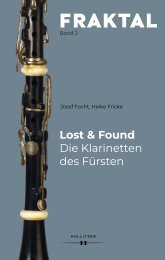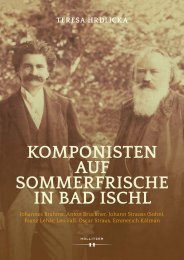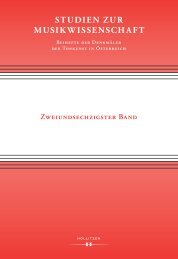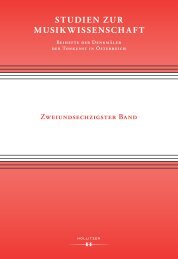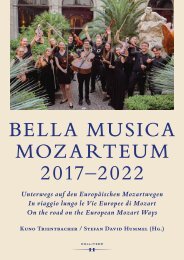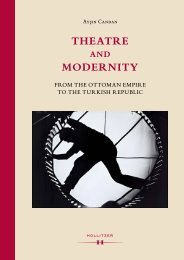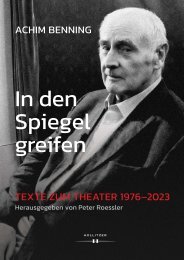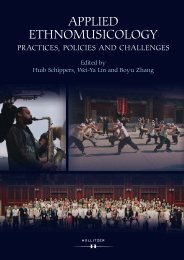You also want an ePaper? Increase the reach of your titles
YUMPU automatically turns print PDFs into web optimized ePapers that Google loves.
DENKMÄLER DER TONKUNST<br />
IN ÖSTERREICH<br />
BAND <strong>163</strong>.3<br />
NEW SENFL EDITION 3<br />
LUDWIG SENFL<br />
MOTETS FOR FIVE VOICES<br />
Edited by<br />
SCOTT LEE EDWARDS<br />
STEFAN GASCH<br />
SONJA TRÖSTER
<strong>DTÖ</strong> <strong>163</strong>.3
DENKMÄLER DER TONKUNST<br />
IN ÖSTERREICH<br />
begründet von<br />
GUIDO ADLER<br />
unter Leitung von<br />
MARTIN EYBL<br />
und<br />
BIRGIT LODES<br />
BAND <strong>163</strong><br />
NEW SENFL EDITION<br />
<strong>DTÖ</strong> <strong>163</strong>.3
DENKMÄLER DER TONKUNST<br />
IN ÖSTERREICH<br />
BAND <strong>163</strong>.3<br />
NEW SENFL EDITION 3<br />
LUDWIG SENFL<br />
MOTETTEN FÜR FÜNF STIMMEN<br />
Herausgegeben von<br />
SCOTT LEE EDWARDS<br />
STEFAN GASCH<br />
SONJA TRÖSTER
DENKMÄLER DER TONKUNST<br />
IN ÖSTERREICH<br />
VOLUME <strong>163</strong>.3<br />
NEW SENFL EDITION 3<br />
LUDWIG SENFL<br />
MOTETS FOR FIVE VOICES<br />
Edited by<br />
SCOTT LEE EDWARDS<br />
STEFAN GASCH<br />
SONJA TRÖSTER<br />
<strong>DTÖ</strong> <strong>163</strong>.3
Dieser Band wird an die beitragenden Mitglieder<br />
der Gesellschaft zur Herausgabe von Denkmälern der Tonkunst in Österreich (Subskribenten)<br />
zu wesentlich ermäßigtem Preis abgegeben.<br />
Bei Aufführungen der in diesem Band veröffentlichten Werke sind<br />
die Denkmäler der Tonkunst in Österreich als Quelle auf Programmen, in Ansagen usw. zu nennen.<br />
Veröffentlicht mit Unterstützung des<br />
Austrian Science Fund (FWF):<br />
PUB 792-G<br />
(Forschungsergebnisse des FWF-Projektes P 27469)<br />
Leitung: Stefan Gasch<br />
Open Access: Wo nicht anders festgehalten, ist diese Publikation<br />
lizenziert unter der Creative-Commons-Lizenz Namensnennung 4.0;<br />
siehe http://creativecommons.org/licenses/by/4.0/<br />
Satz: Gabriel Fischer<br />
Notensatz: Scott Lee Edwards, Stefan Gasch, Sonja Tröster<br />
Hergestellt in der EU<br />
© 2022 by HOLLITZER Verlag, Wien<br />
ISMN 979-0-50270-023-2<br />
ISBN 978-3-99012-945-6<br />
ISSN 2616-8987
TABLE OF CONTENTS<br />
GENERAL INTRODUCTION<br />
AND ACKNOWLEDGEMENTS ................................... IX<br />
INTRODUCTION .............................................................. XI<br />
PLATES ................................................................................ XXV<br />
1. Ave, Rosa sine spinis ......................................................... 1<br />
2.p. Dominus tecum / Benedicta tu ................................ 6<br />
2. Christus, resurgens ex mortuis /<br />
Christ ist erstanden ......................................................... 12<br />
3. Conditor alme siderum .................................................. 17<br />
4. Da pacem, Domine (ii) ................................................... 19<br />
2.p. Quia non est alius .................................................... 21<br />
5. Da pacem, Domine (iii) ................................................. 23<br />
2.p. Quia non est alius .................................................... 26<br />
6. De profundis clamavi (ii) ............................................... 29<br />
2.p. A custodia matutina ................................................ 35<br />
7. Genuit puerpera Regem ................................................. 39<br />
8. In te, Domine, speravi (i) ............................................... 44<br />
9. In te, Domine, speravi (ii) .............................................. 48<br />
10. Oratio ad incomparabilem Virginem Mariam<br />
Mater digna Dei / Ave, sanctissima Maria .................. 52<br />
2.p. Nixa Deum, defende /<br />
Tu es singularis Virgo .............................................. 55<br />
3.p. Deus propitius esto / Ora pro nobis ...................... 59<br />
11. Media vita in morte sumus /<br />
Inmitten unsers Lebens Zeit .................................. 62<br />
2.p. Sancte Deus, sancte fortis /<br />
Heiliger Herre Gott ................................................. 65<br />
12. Miserere mei, Deus .......................................................... 68<br />
2.p. Asperges me, Domine /<br />
Miserere mei, Deus .................................................. 75<br />
3.p. Domine, labia mea aperies /<br />
Miserere mei, Deus .................................................. 84<br />
13. Missus est Angelus Gabriel ............................................ 91<br />
14. Ne reminiscaris, Domine ............................................... 94<br />
15. Nisi Dominus aedificaverit domum ............................. 98<br />
2.p. Cum dederit dilectis suis somnum ..................... 103<br />
16. O admirabile commercium ......................................... 107<br />
17. *O crux, ave, spes unica / Fortuna .............................. 112<br />
18. O gloriosum lumen ....................................................... 115<br />
2.p. Qui in terra positus ............................................... 119<br />
3.p. Illuc supplices tuos ................................................. 122<br />
19. O sacrum convivium (i) ............................................... 126<br />
2.p. Mens impletur gratia ............................................. 130<br />
20. O sacrum convivium (ii) .............................................. 135<br />
21. Omnes gentes, plaudite manibus ............................... 141<br />
2.p. Ascendit Deus in iubilo ........................................ 148<br />
22. Qui prophetice prompsisti ........................................... 157<br />
2.p. Qui expansis in cruce manibus ........................... 160<br />
3.p. Vita in ligno moritur ............................................. 162<br />
[4.p. Christus Dominus factus est obediens] ........... 165<br />
[5.p. Domine, miserere] ................................................ 169<br />
23. Quomodo fiet istud ....................................................... 173<br />
2.p. Audi, Maria Virgo ................................................. 175<br />
24. Salva nos, Domine, vigilantes ..................................... 178<br />
25. Saulus autem, adhuc spirans /<br />
Petrus Apostolus ..................................................... 181<br />
2.p. ‘Saule, Saule, quid me persequeris’ /<br />
Petrus Apostolus ..................................................... 185<br />
26. Si enim credimus ........................................................... 189<br />
2.p. Et sicut in Adam .................................................... 193<br />
3.p. Requiem aeternam ................................................. 195<br />
27. Sum tuus in vita (ii) ...................................................... 197<br />
2.p. Cur rigido latuit ..................................................... 201<br />
28. Tanto tempore vobiscum /<br />
Philippe, qui videt me ........................................... 204<br />
2.p. Non turbetur cor vestrum /<br />
Philippe, qui videt me ........................................... 209<br />
29. Te Deum laudamus ....................................................... 214<br />
30. Tota pulchra es ............................................................... 233<br />
2.p. Iam enim hiems transiit ....................................... 237<br />
3.p. Et vox turturis ......................................................... 241<br />
31. Vivo ego, dicit Dominus .............................................. 245<br />
2.p. Quis scit si convertatur ......................................... 247<br />
CRITICAL APPARATUS<br />
Editorial Conventions .......................................................... 251<br />
General and Bibliographical Abbreviations ..................... 255<br />
RISM Sigla of Libraries ....................................................... 256<br />
Sources .................................................................................... 258<br />
Bibliography ........................................................................... 269<br />
Critical Reports ..................................................................... 277<br />
Alphabetical Index of Text Incipits ................................... 383<br />
<strong>DTÖ</strong> <strong>163</strong>.3
IX<br />
GENERAL INTRODUCTION<br />
AND ACKNOWLEDGEMENTS<br />
Ludwig Senfl (c.1490–1543) can be regarded as a leading figure<br />
in the world of German-speaking composers between<br />
Heinrich Isaac and Orlando di Lasso as well as a European<br />
composer of the first rank, standing alongside such<br />
renowned contemporaries as Costanzo Festa, Philippe<br />
Verdelot, Nicolas Gombert, and Adrian Willaert. His extensive<br />
œuvre encompasses a broad range of vocal genres of<br />
the time and was composed in the course of his employment<br />
at two of the most important courts of the early sixteenth<br />
century: at the court of Emperor Maximilian I he<br />
launched his career as a singer and composer, and from 1523<br />
on he worked as court composer for Duke Wilhelm IV of<br />
Bavaria. At Wilhelm’s request, Senfl built the Munich Hofkapelle<br />
into a professional ensemble modelled, in regard to<br />
repertoire and organisation, on the imperial chapel.<br />
Senfl’s significance was already recognised in the nineteenth<br />
century, yet two efforts to publish his works in a<br />
modern edition were prematurely discontinued. These editions<br />
therefore provide only a fraction of Senfl’s overall<br />
compositional production and have resulted in the scholarly<br />
neglect of his œuvre, especially his motets. A new and complete<br />
edition of his works has been a desideratum for many<br />
years, a gap that the New Senfl Edition seeks to fulfil.<br />
Critical preliminary work for a complete edition of<br />
Senfl’s compositions involved the compilation of a catalogue<br />
raisonné, an undertaking realised through the generous<br />
funding of the Austrian Science Fund (FWF) between 2008<br />
and 2014 under the direction of Birgit Lodes. This publication<br />
(herein referred to as the Senfl Catalogue or SC) provides<br />
an essential foundation for the documentation of<br />
works and sources in the New Senfl Edition.<br />
The edition of the motets, which forms the beginning<br />
of the collected works, will be presented in four volumes, in<br />
which the compositions are organised according to scoring<br />
and alphabetical order. Six pieces conceived as pure canons<br />
conclude the final volume of motets.<br />
Vol. 1: 26 motets à 4 (A–I)<br />
Vol. 2: 29 motets à 4 (N–V) + 1 Fragment<br />
Vol. 3: 31 motets à 5<br />
Vol. 4: 15 motets à 6; 3 motets à 8; 6 canons<br />
***<br />
The editors of the edition owe thanks to many colleagues<br />
and institutions for their help and support. Without the<br />
Austrian Science Fund (FWF), which provided generous<br />
financial assistance (P 27469), the work of the edition would<br />
not have been possible. The Department of Musicology at<br />
the University of Vienna (Birgit Lodes) and the Department<br />
of Musicology and Performance Studies at the University<br />
of Music and Performing Arts Vienna (Nikolaus<br />
Urbanek) cordially hosted the project within their premises.<br />
We also would like to express our thanks to the many<br />
libraries and archives that provided reproductions of sources<br />
for Senfl’s music. Especially important to mention are<br />
the following institutions, whose personnel greatly facilitated<br />
the work of the edition through their kind and ready<br />
responses to our inquiries:<br />
Dresden, Sächsische Landesbibliothek –<br />
Staats- und Universitätsbibliothek Dresden, SLUB<br />
(Christine Sawatzki, Andrea Hammes)<br />
Hradec Králové, Muzeum východních Čech<br />
v Hradci Králové (Jaroslava Pospíšilová)<br />
Klosterneuburg, Augustiner-Chorherrenstift,<br />
Bibliothek (Martin Haltrich)<br />
Melk, Benediktinerstift, Stiftsbibliothek und<br />
Musikarchiv (Bernadette Kalteis)<br />
München, Bayerische Staatsbibliothek<br />
(Veronika Giglberger, Bernhard Lutz)<br />
Regensburg, Bischöfliche Zentralbibliothek,<br />
Proskesche Musikabteilung (Raymond Dittrich)<br />
Stuttgart, Württembergische Landesbibliothek<br />
(Arietta Ruß)<br />
Wien, Österreichische Nationalbibliothek<br />
(Thomas Leibnitz)<br />
Wien, Fachbereichsbibliothek Musikwissenschaft,<br />
Universitätsbibliothek Wien (Benedikt Lodes)<br />
Zwickau, Ratsschulbibliothek (Gregor Hermann)<br />
<strong>DTÖ</strong> <strong>163</strong>.3
X<br />
As heads of publications for the Denkmäler der Tonkunst<br />
in Österreich, Martin Eybl and Birgit Lodes have placed<br />
their trust in our work. They accompanied the creation of<br />
the edition from its initial stages, and most graciously accepted<br />
the volumes for publication in the <strong>DTÖ</strong> series.<br />
We have repeatedly received constructive feedback on<br />
our work through various academic exchanges that have<br />
proven invaluable for the advancement and development of<br />
the edition. Intensive discussions on editorial approaches,<br />
issues, and guidelines were held with our advisory board, in<br />
which Bonnie Blackburn, David Burn, Bernhold Schmid<br />
alongside Andrea Lindmayr-Brandl and Birgit Lodes as representatives<br />
of the editorial board of the <strong>DTÖ</strong> participated<br />
and generously gave their time. We thank them for always<br />
lending an open ear to our questions.<br />
We also received generous help on a more individual<br />
level. Lenka Hlávková, Ton Oliveira, and Mateusz Zimny<br />
assisted us in gaining access to sources in the Czech Republic<br />
and Poland. Bonnie Blackburn and Leo franc Holford-<br />
Strevens provided invaluable help in linguistic and formal<br />
corrections of the volumes, and Joshua Rifkin provided<br />
critical editorial feedback in the early stages of the edition.<br />
Sabine Ladislav was always willing to assist in organising<br />
workshops and meetings, and without the technical and<br />
creative inclinations of Imke Oldewurtel, the edition would<br />
not be enhanced by clefs modelled on sixteenth-century<br />
sources.<br />
Just as importantly, the enthusiastic members of the<br />
New Senfl Choir and the ensemble Stimmwerck critically<br />
evaluated and tested our editions through numerous rehearsals<br />
and performances.<br />
To the countless colleagues and institutions not already<br />
mentioned we also extend thanks, and last but not least to<br />
the Hollitzer Wissenschaftsverlag: Felix Loy kindly took<br />
care of the proof-reading and copy editing; Gabriel Fischer<br />
provided an elegant layout and patiently included all our<br />
corrections; Michael Hüttler and Sigrun Müller supported<br />
the printing of the volumes with great enthusiasm and readily<br />
agreed to the funding strategy of the FWF by publishing<br />
both in traditional printed and future-oriented open access<br />
formats.<br />
The Editors Vienna, March 2022<br />
<strong>DTÖ</strong> <strong>163</strong>.3
XI<br />
INTRODUCTION<br />
EXPANDING THE TEXTURE, MASTERING THE SOUND:<br />
LUDWIG SENFL’S MOTETS FOR FIVE VOICES<br />
The repertoire of five-voice motets by Ludwig Senfl, fully<br />
edited in the present volume for the first time, casts new<br />
light on the composer by expanding our view of his multifaceted<br />
body of work in the genre. Once again, text, music,<br />
and cantus firmus are closely related components, whose<br />
layers of immanent meaning converge with one another in<br />
a variety of ways. On the surface, Senfl’s numerous canonic<br />
and quasi-canonic works demonstrate his interest in challenging<br />
compositional techniques, while his polytextual<br />
compositions harness the interpenetration of diverse musical<br />
material to emphasise a message or meaning. Works<br />
alluding to Josquin highlight Senfl’s ongoing engagement<br />
with his role model, often expressed through the expansion<br />
of self-imposed compositional problems, the pursuit of<br />
independent solutions, or even his mastery over their means<br />
of expression. The motets presented here reveal Senfl not<br />
just as a musician at the forefront of text-based sonic effects,<br />
compositional innovations and their rhythmic realisation,<br />
but moreover as one who understood the application of<br />
these techniques in the spirit of a musical pastor, adroitly<br />
harnessing the poetic structure of psalms, exegesis, or intertextual<br />
relationships in the design of a work.<br />
Senfl turned his attention with increased intensity from<br />
four-voice to five-voice motet writing beginning in the 1520s<br />
and mobilised a range of compositional techniques to<br />
achieve this textural expansion: free imitative settings, cantus<br />
firmi framed by paired imitative voices, canon or quasi-canon<br />
in two or three voices, the broader application of<br />
simultaneous cantus firmi, the use of ostinato structures, or<br />
the climactic textural amplification from four to five voices.<br />
He deployed these techniques to enhance and diversify the<br />
sonorous impact of his motets or deepen their meanings<br />
through associative juxtaposition, and in doing so he became<br />
a standard-bearer for other composers in Central<br />
Europe. As in his four-voice œuvre, the majority of his fivevoice<br />
motets are antiphon settings, but we also find among<br />
them settings of hymns, psalms, Marian prayers, other biblical<br />
and liturgical texts, a humanist poem by the Lutheran<br />
theologian Veit Dietrich, sacred lieder, and one of several<br />
compositions based on the tenor of the Italian song Fortuna<br />
desperata attributed to the composer.1 The range of his fivevoice<br />
motets mirrors the diverse liturgical, para-liturgical,<br />
1 Although the attribution of *O crux, ave / Fortuna (SC *M 71<br />
attr.) to Senfl by Martin Staehelin remains a subject of debate,<br />
Senfl’s authorship of seven other Fortuna settings (SC S 106,<br />
108–13) is secure. See Staehelin 1973: 86 as well as the Critical<br />
Report in NSE 3.17.<br />
and non-liturgical circumstances2 in which these motets<br />
were performed, whether in courtly or civic ceremony, for<br />
private devotion, in scholastic settings, as instrumental arrangements,<br />
or for worship ranging across the sixteenth-century<br />
confessional spectrum.<br />
From Court to Public Sphere:<br />
The Sources of Senfl’s Five-Voice Motets<br />
Senfl’s five-voice motets survive in 78 manuscripts and 18<br />
prints, in addition to 14 manuscript and printed tablatures<br />
for lute and keyboard. The geographical topography of the<br />
manuscripts provides important evidence for how these<br />
motets circulated. A high density of sources originated in<br />
the vicinity of Senfl’s employment (20 manuscripts from the<br />
ducal court in Munich and the free imperial cities of Augsburg<br />
and Regensburg) and in Saxony (21 manuscripts from<br />
the cities of Glashütte, Leipzig, Meißen, Pirna, Torgau,<br />
Wittenberg, Zwickau). Here, in Central Germany, an especially<br />
high number of works can be found in sources from<br />
scholastic institutions, such as the Fürstenschule St. Afra in<br />
Meißen or the Thomasschule in Leipzig. This scholastic<br />
background is shared by other manuscripts compiled for the<br />
Gymnasium Poeticum in the south German city of Regensburg<br />
and the Poetenschule in Salzburg. Senfl’s motets, however,<br />
also survive in sources from the Württemberg court in<br />
Stuttgart (four manuscripts) and the city of Breslau (today<br />
Wrocław, six manuscripts), as well as in sources dispersed<br />
across the neighbouring kingdoms of Denmark, Poland,<br />
Bohemia, and Upper Hungary.<br />
The international distribution of the five-voice motets<br />
speaks both to the quality of the works and to the high<br />
esteem in which Senfl was held across the Central European<br />
map. His pre-eminence arose from various circumstances,<br />
including his personal correspondence with Martin Luther<br />
or the central place accorded his music in early printed<br />
motet anthologies, and widespread appreciation for his<br />
works is manifest through his connections to other<br />
representatives of the early Reformation period, as demonstrated<br />
by the group of ‘Walter-Handschriften’ and his correspondence<br />
with Albrecht of Prussia, partially carried out<br />
on Senfl’s behalf by his colleague Lucas Wagenrieder (see<br />
Plate 24).<br />
In regard to the dating of sources, a chronological difference<br />
distinguishes the sources for five-voice motets from<br />
those transmitting his four-voice motets. With the excep-<br />
2 A striking absence in this volume is the genre of ‘Staatsmotette’<br />
as defined by Albert Dunning, which, in fact, appears rarely in<br />
Senfl’s œuvre. Dunning 1969.<br />
<strong>DTÖ</strong> <strong>163</strong>.3
XII<br />
tion of two early manuscripts, all other sources date primarily<br />
from the second and third quarters of the sixteenth century:<br />
from the period around 1520, the manuscripts<br />
V-CVbav Cod. Vat. lat. 11953 and the ‘Pernner Codex’ (D-<br />
Rp C 120) include only two five-voice motets (Salva nos,<br />
Domine, vigilantes, SC M 94; NSE 3.24 along with the questionably<br />
attributed *O crux, ave, spes unica / Fortuna, SC *M<br />
71; NSE 3.17), while the Zwickau source D-Z 81/2, which<br />
dates from the second quarter of the sixteenth century and<br />
shares several concordances with the ‘Pernner Codex’,<br />
transmits none. On this basis, it is reasonable to assume<br />
that Senfl amplified his focus on five-voice motet composition<br />
around 1520,3 an assessment which is also evident in<br />
the greater variety of musical textures found in the fivevoice<br />
motets.<br />
Among the sources transmitting this body of work, the<br />
Munich choirbooks again provide invaluable direct testimony<br />
to musical performance at the ducal court in Munich<br />
during Senfl’s tenure there. The two choirbooks D-Mbs<br />
Mus.ms. 10 and 12 are closely related manuscripts: Martin<br />
Bente has already drawn attention to the similar editorial<br />
approach in these two choirbooks,4 which transmit motets<br />
by Josquin and Senfl exclusively. The motets were compiled<br />
in fascicles and may have been used as such in the court<br />
chapel before they were bound together in the mid-1530s.5<br />
The ‘Motettorum Liber Primus’ (Mus.ms. 12)6 contains a<br />
primarily Marian repertoire, arranged according to the<br />
number of voices, while the ‘Motettorum Liber Secundus’<br />
(Mus.ms. 10) is almost entirely devoted to music in honour<br />
of Christ (including the Quinque Salutationes Domini Nostri<br />
Jesu Christi, SC M 8; NSE 1.3). The compilation of the two<br />
volumes thus provide a concrete repertoire of works for the<br />
veneration of Mary and Christ at the court of Duke<br />
Wilhelm IV.<br />
A specific program evident in the two choirbooks clarifies<br />
the order of the motets as part of a larger overall concept:<br />
Mus.ms. 12, the ‘Marian choirbook’, opens with a<br />
three-part Verbum caro factum est, the final response for<br />
Matins on Christmas Day, which addresses the motherhood<br />
of Mary and the incarnation of Christ. This dual perspective<br />
continues in Josquin’s Pater noster / Ave Maria,<br />
which is followed by Senfl’s six-voice adaptation of Josquin’s<br />
Ave, Maria … Virgo serena (SC M 9; NSE 4.1), Mater digna<br />
Dei / Ave, sanctissima Maria (SC M 56; NSE 3.10), and Ave,<br />
Rosa sine spinis (SC M 10; NSE 3.1). Those four motets not<br />
only translate the traditional prayers into music, but in each<br />
case also conclude with a clear supplication, reflecting how<br />
intrinsic such petitions were to sixteenth-century piety, a<br />
preoccupation abundantly manifest in both music and the<br />
visual arts. Moreover, the Pater noster and Ave Maria are<br />
precisely those texts endowed in 1490 as a Salve devotion by<br />
Wilhelm’s father in honour of late members of the Wittelsbach<br />
family.7 According to the ducal endowment, the largest<br />
bell was to be rung first, followed by recitation of a Pater<br />
noster and an Ave Maria in memory of the deceased ancestors<br />
of the duke, then the Salve ‘in mensuris’, and finally a<br />
Miserere intoned by the clergy, schoolmaster and cantor in<br />
honour of Emperor Ludwig IV of Bavaria (1282/6–1347), the<br />
latter of which appears in a polyphonic setting by Senfl in<br />
the ‘Christian choirbook’ D-Mbs Mus.ms. 10 (SC M 58;<br />
NSE 3.12). Wilhelm IV maintained the tradition of Marian<br />
devotion championed by his father and expanded it on a<br />
large scale, especially around the mid-1520s. Traces of a<br />
growing need for paraliturgical polyphonic music can be<br />
found in the choirbook D-Mbs Mus.ms. 34, which contains<br />
only Salve settings,8 as well as in Senfl’s Magnificat cycle<br />
(NSE 5), which may have originated at this time.9 With this<br />
music, the singers would thus have sung not only for the<br />
salvation of living and deceased members of the Wittelsbach<br />
family, but also for themselves.<br />
Other manuscript sources attesting to the high regard<br />
for Senfl’s five-voice motets beyond the ducal court include<br />
the ‘Eisenacher Kantorenbuch’ (D-EIa s.s.); a set of partbooks<br />
from the Thomasschule in Leipzig (D-LEu Thomaskirche<br />
49/50); the so-called ‘Walter-Handschriften’<br />
(D-GOl Chart. A 98, D-Ngm 83795 [T], D-Ngm 83795 [B],<br />
D-WRhk MS B, PL-Kj Mus. ms. 40013, PL-Kj Mus. ms.<br />
40043), all of which originated in Torgau; and the manuscripts<br />
of the Fürstenschule St. Afra in Meißen (Saxony).10<br />
These partbook sets from Leipzig and Meißen affirm that in<br />
Protestant areas, Senfl’s music occupied an especially important<br />
place in schools, whether used for musical instruction<br />
or for worship. In southern German-speaking lands,<br />
other manuscripts transmitting Senfl’s five-voice motets<br />
from the Gymnasium Poeticum in Regensburg and the<br />
Poetenschule in Salzburg were prepared for similar purposes.<br />
Among printed sources transmitting five-voice motets,<br />
only a third were issued during the composer’s lifetime.11<br />
The most important city for the printing of Senfl’s motets is<br />
Nuremberg. Before and after his death, 66 anthologies including<br />
compositions by Senfl were published in this<br />
important printing centre, primarily by the printshops of<br />
3 The only exception for a motet with larger scoring before 1520 is<br />
the six-voice Sancte pater, divumque decus / Sancte Gregori, confessor<br />
Domini (SC M 103; NSE 4.11). It was possibly composed in<br />
1516 and appeared just once in print in the Liber selectarum cantionum<br />
(Augsburg: Sigmund Grimm and Marx Wirsung, 1520;<br />
RISM 15204).<br />
4 Bente 1968: 63–70.<br />
5 A clue is provided in D-Mbs Mus.ms. 10 by Qui prophetice<br />
prompsisti, whose three parts were not completed before 1537 but<br />
are nevertheless included in Mus.ms. 10. SC 2: 72–3.<br />
6 This original title, once found on the outside cover of the choirbook,<br />
is now pasted on the inside cover.<br />
7 The endowment had existed since 1486 but was renewed in 1490.<br />
Monumenta Boica 1811, no. 378: 696–8; see also Söhner 1934: 7–8.<br />
The tentative programme of the two choirbooks was first observed<br />
in Gasch 2016.<br />
8 The choirbook was prepared in the workshop of Petrus Alamire.<br />
Kellman 1999: 118.<br />
9 Gasch 2017.<br />
10 Moritz von Sachsen founded the Fürsten- und Landesschulen<br />
St. Afra in Meißen, Schulpforta (Naumburg), and St. Augustin<br />
in Grimma in 1543 to prepare boys for university. Heidrich 2002:<br />
97–9; Menzel 2017.<br />
11 Among them is Brown 1533₁, which provides an intabulation for<br />
lute of Senfl’s Nisi Dominus.<br />
<strong>DTÖ</strong> <strong>163</strong>.3
XIII<br />
Hieronymus Formschneider, Johannes Petreius, and Johann<br />
vom Berg and Ulrich Neuber.12 Outside Nuremberg, only<br />
two other printers issued five-voice works by Senfl in motet<br />
anthologies: Georg Rhau in Wittenberg (RISM 153914) and<br />
Philipp Ulhart in Augsburg (RISM 15452).<br />
In contrast to manuscript sources, which exhibit depth<br />
and variety in the transmission of Senfl’s five-voice motets,<br />
printed sources are relatively circumscribed in terms of the<br />
numbers of five-voice motets they transmit. This reduction<br />
in numbers is partially due to differences between sixteenth-century<br />
and modern definitions of the term ‘motet’.<br />
The first printed motet anthology in German-speaking<br />
lands, the Liber selectarum cantionum (Augsburg: Sigmund<br />
Grimm and Marx Wirsung, 1520) (RISM 15204), a print in<br />
which Senfl seems to have played a direct role in assembling,<br />
includes six settings by Senfl and is therefore an important<br />
early source for Senfl’s motets. This print includes<br />
one five-voice setting by the composer, Gaude Maria Virgo<br />
(SC P 102). Although the table of contents for this source<br />
describes all of its settings as ‘mutetae’, Gaude Maria Virgo<br />
is structured as a responsory for the Feast of the Purification<br />
of the Virgin and will therefore be published in a future<br />
volume of mass proper settings. A similar situation holds for<br />
Senfl’s five-voice Grates nunc omnes (P 5c), a sequence for the<br />
Nativity of Christ that Georg Forster edited in his Selectissimarum<br />
mutetarum partim quinque partim quatuor vocum<br />
tomus primus (Nuremberg: Johannes Petreius, 1540) (RISM<br />
15406). Although most of the 18 prints transmitting Senfl’s<br />
five-voice motets provide only one such setting, many of<br />
these sources include other motets by the composer for differing<br />
numbers of voices or, especially in the case of tablatures,<br />
Senfl’s lieder, which circulated in profusion through<br />
at least twelve known prints between the years 1520 and<br />
1537.<br />
Of fundamental importance for the circulation of the<br />
composer’s five-voice motets is the first volume of Hans<br />
Ott’s Novum et insigne opus musicum (RISM 15371). It is only<br />
the second motet anthology published in the German-speaking<br />
lands, after the early Liber selectarum, and includes five<br />
motets for five voices among its thirteen compositions attributed<br />
to Senfl. Ott included an additional five-voice motet<br />
in the second volume of this anthology, Secundus tomus<br />
novi operis musici (RISM 15383), alongside four other motets<br />
ascribed to the composer (one of which, Costanzo Festa’s<br />
Quis dabit oculis nostris, no. 32, Ott misattributes to Senfl).<br />
The contents of these volumes were highly influential on<br />
12 Other printers of Senfl’s motets are Hans Guldenmundt (Brown<br />
1540₁), Hans Günther (Brown 1544₁ – ₂), Christoph Gutknecht<br />
(Brown 1547₄), Julius Paulus Schmidt (Brown 1549₆), and Theodor<br />
and Katharina Gerlach (RISM 15671, RISM 15691, Brown<br />
1583₂). Theoretical writings published in Nuremberg with examples<br />
by Senfl include two books by Sebald Heyden (Musicae id est<br />
artis canendi and De arte canendi (Johannes Petreius, 1537 and<br />
1540, respectively)), Ambrosius Wilphlingseder’s Erotemata musices<br />
(Christoph Heussler, 1563), Johannes Rivius’s Institutionum<br />
grammaticarum (Ulrich Neuber/Theodor Gerlach, 1566), and<br />
Andreas Raselius’s Hexachordum (Katharina Gerlach, 1589). See<br />
SC 2: 380–3.<br />
manuscript anthologies, in which much of this repertoire<br />
was copied. In the second volume of the revised and expanded<br />
new edition of Ott’s anthology published in 1559<br />
(RISM 15591), issued by Johann vom Berg and Ulrich Neuber<br />
more than ten years after Ott’s decease, only the two<br />
five-voice motets Ave, Rosa sine spinis and Qui prophetice<br />
prompsisti are included from the earlier edition, but augmented<br />
by a motet that Johannes Petreius had first printed<br />
in Forster’s Selectissimarum mutetarum referenced above<br />
(RISM 15406), O admirabile commercium (SC M 69; NSE<br />
3.16).<br />
Like Hans Ott, Georg Forster was an advocate of Senfl’s<br />
music, even if he was not always accurate in his attributions.<br />
In addition to five settings in RISM 15406, Forster included<br />
four settings attributed to Senfl, among them Ne reminiscaris,<br />
Domine (SC M 63; NSE 3.14) from the present volume<br />
and the three- to six-voice canon Laudate Dominum<br />
omnes gentes (SC M 52; NSE 4.21), in his three-volume series<br />
Psalmorum selectorum (RISM 15386, 15399, and 15426), also<br />
printed by Petreius. One of these motets, Deus in adiutorium,<br />
first printed in the Liber selectarum, is, however, more<br />
likely the work of Nicolas Champion, while the four-voice<br />
In Domino confido attributed by Forster in the index to Senfl<br />
is instead by Jacquet of Mantua.<br />
After publication of the final volume of the Psalmorum<br />
selectorum in 1542, the next known appearance of a fivevoice<br />
motet by Senfl in print is Quomodo fiet istud (SC M 91;<br />
NSE 3.23) in the anthology Concentus octo, sex, quinque &<br />
quatuor vocum (Augsburg: Philipp Ulhart, 1545) (RISM<br />
15452), edited by Sigmund Salminger. Quomodo fiet istud appeared<br />
subsequently twice more in print: in Hermann<br />
Finck’s Practica musica (Wittenberg: Georg Rhau’s heirs,<br />
1556), where it is used to illustrate canon in both tempus<br />
perfectum and tempus imperfectum, and then again twelve<br />
years later in the Cantiones triginta (Nuremberg: Ulrich<br />
Neuber, 1568) (RISM 15687) edited by Clemens Stephani,<br />
another later champion of Senfl’s music. But in terms of<br />
popularity and longevity, it is Senfl’s Qui prophetice prompsisti<br />
that circulated most widely of all in print, primarily<br />
through books of tablatures. Following its first printed appearance<br />
in Ott’s Novum et insigne opus musicum in 1537,<br />
Hans Newsidler provided an intabulated version in the<br />
third volume of his Lautenbüchlein (Brown 15443). This was<br />
followed by three more intabulations for lute between 1547<br />
and 1558, one of which, Simon Gintzler’s Intabolatura de<br />
lauto (Brown 15473), printed in Venice by Antonio Gardano,<br />
represents the first of only two sixteenth-century sources issued<br />
in Venice to include compositions by Senfl (the second<br />
being Ludovico Zacconi’s Prattica di musica of 1592). After<br />
the reissue of Qui prophetice prompsisti in the revised version<br />
of Ott’s anthology in 1559, intabulations of the motet were<br />
reprinted at least three more times: in 1574 for lute by<br />
Melchior Newsiedler, and twice in 1583 for organ by Jacob<br />
Paix (Brown 15834) and Johannes Rühling von Born (Brown<br />
15836). In each instance, the order of the motet’s three parts<br />
follows the order first published by Ott in 1537 and repeated<br />
by Berg and Neuber in 1559, which places the third part of<br />
the motet first (see the discussion at the end of this<br />
introduction), a testament to the lasting impact of these<br />
<strong>DTÖ</strong> <strong>163</strong>.3
XIV<br />
motet anthologies in disseminating and popularising Senfl’s<br />
music.13<br />
Preaching the Psalter: Senfl’s Psalm Motets<br />
Defined as polyphonic elaborations of complete or integral<br />
portions of psalm texts, psalm motets marked a path-breaking<br />
innovation in sixteenth-century composition, in which<br />
Senfl, following the model of Josquin, played an essential<br />
role.14 The genre, which grew in stature after the turn of the<br />
century, capitalised on the liturgical independence15 and<br />
flexibility of the psalter’s expressive poetic texts as well as its<br />
personal narrative style, which contributed to the advancement<br />
of the genre as an innovative ‘art of expression’ (‘Ausdruckskunst’).16<br />
New interest in the textual and contextual<br />
meaning of the psalter made the psalm motet, in turn, an<br />
ideal instrument for the vivid elaboration of biblical texts<br />
and a vehicle for memorising religious teaching, a development<br />
that was by no means limited to adherents of reformed<br />
faiths.<br />
Freedom from cantus-firmus construction gave the<br />
composer licence to employ a range of contrapuntal techniques<br />
and to craft exegetical settings, which, in view of the<br />
impending threats from the Ottoman Empire and Reformations,<br />
became a mirror for individual experience in the<br />
face of contemporary political and religious upheavals. The<br />
musical heightening of textual content was grounded in the<br />
two-part structure of the psalm verse and — as manifest in<br />
the combination of psalmody with polyphony — realised in<br />
a syllabic text setting that often features the conspicuous<br />
juxtaposition of paired duos or compositional forms based<br />
on ostinati or refrains, precisely those compositional principles<br />
found in Ecce quam bonum (SC M 38; NSE 1.20), Miserere<br />
mei, Deus (SC M 58; NSE 3.12), or Omnes gentes, plaudite<br />
manibus (SC M 79; NSE 3.21).<br />
New and intensive study of the psalter in the sixteenth<br />
century — a phenomenon reflected in the numerous publications<br />
of psalm exegeses — was thus complemented by the<br />
production of printed anthologies of psalm motets in the<br />
13 Paix subsequently included an intabulation of O sacrum convivium<br />
(ii) (NSE 3.20), a setting transmitted without attribution in<br />
RISM 15371, in his Thesaurus motetarum of 1589 (Brown 1589₆),<br />
the only sixteenth-century source to attribute this setting to<br />
Senfl (see Plate 21). It is possible that this attribution results from<br />
his interpretation of the table of contents in Ott’s anthology,<br />
where Senfl’s name is listed in conjunction with Ave, Rosa sine<br />
spinis (no. 22 in Ott’s anthology), and the titles of compositions<br />
numbered 23–6 (O sacrum convivium (ii) appears as no. 24) are<br />
given no attributions. See this volume, Critical Report no. 20.<br />
14 On the history and development of the psalm motet in the German-speaking<br />
lands, see Dehnhard 1971; for an overall overview<br />
of the repertoire, see Nowacki 1979; for a discussion on the aesthetics<br />
of the psalter as the reason for the new interest in the<br />
genre, see Finscher 1995; see also Steele 1993.<br />
15 There is still no clear picture of the liturgical performance of<br />
motets. Jürgen Heidrich (1998: 134 n. 2) is critical of the thesis<br />
implied by Nowacki 1979: 179–80 in Table IV and followed by<br />
Ludwig Finscher, that motets which include the Doxology were<br />
used in the liturgy. Still today this thesis remains in question.<br />
16 Heidrich 1998: 113; Finscher 1995.<br />
1530s for Catholic and reformed worship alike.17 As valuable<br />
elaborations of sacred texts for personal use in the practical<br />
world, psalm settings were versatile compositions that could<br />
be performed in a variety of contexts, and, as the source<br />
transmission of Senfl’s body of work in this genre confirms,<br />
were enthusiastically received across the Catholic-Reformation<br />
divide.<br />
Eleven of Senfl’s psalm motets survive today, along with<br />
Laudate Dominum, omnes gentes (SC M 52; NSE 4.21), a<br />
three-voice canon which expands to a six-voice setting of<br />
the complete Psalm 116.18 Senfl’s intensive engagement with<br />
the genre of psalm motet, as well as his indebtedness to the<br />
innovations of Josquin in this subgenre, is evident in two<br />
sources bringing together compositions by both composers:<br />
the 1520 Liber selectarum and the Munich choirbook D-Mbs<br />
Mus.ms. 10. Senfl includes two of his own four-voice psalm<br />
settings in the Liber selectarum, his earliest known forays<br />
into the genre, Usquequo Domine (SC M 118; NSE 2.53), and<br />
Beati omnes (i) (SC M 12; NSE 1.5), and positions them as<br />
the penultimate and final motets in the volume, as if to signal<br />
the novel compositional step forward for the composer<br />
they represent. Two other psalm motet settings in the Liber<br />
selectarum are ascribed to Josquin: the five-voice Miserere<br />
mei, Deus, and a four-voice De profundis clamavi, whose attribution<br />
to Josquin is no longer accepted.19 Josquin’s<br />
Miserere mei, Deus is likewise found in D-Mbs Mus.ms. 10,<br />
along with four additional psalm motets by Senfl: the fourvoice<br />
Deus, in adiutorium (SC M 32; NSE 1.14) and Ecce<br />
quam bonum, and two five-voice settings edited in the present<br />
volume: Miserere mei, Deus and De profundis clamavi (ii)<br />
(SC M 29; NSE 3.6).<br />
Senfl’s internalisation and refinement of Josquin’s composing<br />
procedures is apparent, above all, in Miserere mei,<br />
Deus, a reworking of Josquin’s original setting of the same<br />
text.20 Both works divide the psalm into three partes and<br />
feature an ostinato on the opening words ‘miserere mei,<br />
Deus’ sung by a tenor voice in either an ascending or descending<br />
stepwise pattern of pitches in each pars and once,<br />
in the secunda pars, in diminution. This ostinato derives<br />
from the opening point of imitation in both settings where<br />
the phrase is first sung. While Josquin’s ostinato is based on<br />
a relatively static psalm tone recitation, Senfl opts for a more<br />
artfully conceived melody, possibly based on psalm tone 4<br />
(see this volume, Critical Report no. 12) but reworked to<br />
begin with a striking upward leap of a third. Other refer-<br />
17 Especially noteworthy here are the three motet anthologies printed<br />
in Nuremberg between 1538 and 1542 by Johannes Petreius<br />
(RISM 15386, 15399, 15426) which contain 113 psalm settings, including<br />
works by Senfl; see Teramoto 1983 and Teramoto/Brinzing<br />
1993. For Philip Melanchthon’s theological understanding<br />
of psalms in the 1530s, see Groote 2013: 235–7; for the use of<br />
psalms in private Catholic settings (including Senfl’s Nisi Dominus<br />
compositions), see Lodes 2012 and Lodes 2018.<br />
18 Compositions setting only a section of a psalm, such as De profundis<br />
(i) (SC M 28; NSE 1.12), are not included in this total.<br />
19 The setting is currently believed to be the work of Nicolas Champion.<br />
NJE 15.11, CC.<br />
20 A comparison of these two settings can be found in Fuhrmann<br />
2012: 332–5.<br />
<strong>DTÖ</strong> <strong>163</strong>.3
XV<br />
ences to Josquin include the three-voice setting incorporating<br />
a canon for the verse ‘ecce enim: veritatem dilexisti; incerta<br />
et occulta sapientiae tuae manifestasti mihi’ (‘for<br />
behold: thou hast loved truth; the uncertain and hidden<br />
things of thy wisdom thou hast made manifest to me’) to<br />
evoke the Trinitarian mystery, or the psalm-tone-like recitation<br />
of the first point of imitation in the tertia pars of both<br />
settings. Senfl’s overall design, however, is at once more subtle<br />
and textually associative: in Josquin’s setting, the surrounding<br />
voices interrupt the psalm text to join the tenor 1<br />
in singing the ostinato, transforming it into a refrain,<br />
whereas in Senfl’s setting, the tenor 1 alone sings the ostinato<br />
in longer note values as the other voices continue uninterrupted<br />
with the psalm text. By embedding the repeated<br />
plea for mercy within the unfolding psalm text, Senfl deftly<br />
underscores the very act of psalm recitation itself as insurance<br />
of the gift of deliverance.<br />
In this manner, Senfl also eschews the block-like compositional<br />
structure of Josquin’s setting with its clearly<br />
demarcated symmetries, vocal groupings, and caesuras in<br />
favour of a flowing structure that blurs these markers<br />
through larger, more texturally varied musical units. Nevertheless,<br />
many of the essential characteristics of psalm settings<br />
as defined by Josquin remain in Senfl’s approach: syllabic<br />
declamation; a sparing but telling use of rhetorical<br />
devices such as mimetic textual illustration; and a varied<br />
palette of contrapuntal textures that favours imitative vocal<br />
entries, makes frequent use of paired imitation, and turns to<br />
homophonic declamation to articulate the structure and<br />
give emphasis to phrases of special relevance.<br />
These characteristics are also evident in the second fivevoice<br />
psalm setting by Senfl in D-Mbs Mus.ms. 10, De profundis<br />
clamavi (ii), whose five voices, which include two<br />
voices in the discantus range, contribute in equal measure<br />
to the overall texture. Besides Miserere mei, Deus, this is the<br />
only other penitential psalm for which Senfl is known to<br />
have provided a setting. It was probably composed not long<br />
before July 1535, when he sent this work, along with a copy<br />
of his four-voice Deus, in adiutorium and a now lost sixvoice<br />
setting of the antiphon Quid retribuam, Domine, to<br />
Albrecht, Duke of Prussia.21 Senfl had already edited a fourvoice<br />
De profundis clamavi for the Liber selectarum, where it<br />
is attributed to Josquin. Although now considered the work<br />
of Nicolas Champion, the setting was widely associated<br />
with Josquin’s name in the sixteenth century, and, as Wolfgang<br />
Fuhrmann argues, the attribution in the Liber selectarum<br />
suggests that Senfl likely assumed Josquin’s authorship<br />
as well.22 In contrast to the affinities shared by Josquin’s<br />
and Senfl’s versions of Miserere mei, Deus, Senfl’s setting of<br />
De profundis clamavi departs substantially from the one<br />
included in the Liber selectarum: not only is it scored for the<br />
richer sonority of five voices instead of four, but it also<br />
strikes an exceptionally different tone from the beginning,<br />
with an opening point of imitation that rises stepwise from<br />
the depths of f to cry out to the Lord at the octave above in<br />
three of its voices (see Plates 7–8), in contrast to the Josquin/<br />
21 Gasch 2012.<br />
22 Fuhrmann 2012: 336.<br />
Champion setting that sinks downward by leaps to a low D<br />
in the bassus to paint that very depth. In his sunnier reading<br />
of the motet, Senfl seems less concerned with portraying<br />
the sinner’s pathos than he is in emphasising the confidence<br />
that comes with trust in the Lord.23 Senfl also opts not to<br />
include the lesser doxology that concludes the four-voice<br />
version by Josquin/Champion, which further distances his<br />
setting from association with the liturgy.24 Its high musical<br />
quality and broader applicability likely contributed to its<br />
wide transmission: it can be found in nineteen surviving<br />
manuscripts, one printed source, and two keyboard intabulations,<br />
making it the second most widely transmitted motet<br />
in Senfl’s œuvre, after Qui prophetice prompsisti (SC M<br />
88; NSE 3.22). This stands in stark contrast to Senfl’s setting<br />
of Miserere mei, Deus, which is found uniquely in D-Mbs<br />
Mus.ms. 10, a suggestion that this latter psalm motet may<br />
have been conceived as elite musica reservata for the Munich<br />
court.<br />
De profundis clamavi (ii) later became the subject of a<br />
five-voice parody mass, transmitted in three sources of<br />
(probable) Saxon origins, by the medical doctor Andreas<br />
Gründler.25 Gründler was following a precedent set by<br />
Senfl, not just by writing a parody mass based on Senfl’s<br />
motet, but even by the choice of a psalm motet as the basis<br />
for a cyclic mass setting: when Senfl composed his first and<br />
only parody mass on his own four-voice Nisi Dominus<br />
(SC M 65; NSE 2.29) in the 1520s, he seems to have been one<br />
of the first composers ever to compose a cyclic mass on a<br />
psalm motet.26 In doing so, he thus staked out new compositional<br />
territory that would be further explored by successors<br />
such as Jacobus Clemens non Papa, Pierre de Manchicourt,<br />
Orlando di Lasso, Giovanni Pierluigi da Palestrina,<br />
and Hans Leo Hassler.27 Senfl composed the parody mass,<br />
and probably also the psalm setting, for the Fugger family,<br />
perhaps on the occasion of the wedding of Anton Fugger<br />
and Anna Rehlinger in 1527, making them the first known<br />
musical compositions dedicated to this prominent family.28<br />
The first appearance of Nisi Dominus in print is in the form<br />
of a lute tablature in an anthology assembled by the Nuremberg<br />
lutenist Hans Gerle and printed by Hieronymus Form-<br />
23 Fuhrmann also argues that Senfl’s reading of the psalm text is<br />
influenced by Lutheran ideas. Ibid.: 339.<br />
24 The lesser doxology concludes Senfl’s setting of Ecce quam bonum<br />
as well as the two settings of In exitu Israel (SC M 47 and SC *M<br />
48 attr.; NSE 1.25 and 26) attributed to him.<br />
25 This parody mass can be found in D-Dl Mus. Pi Cod. VIII, the<br />
source that identifies his name in the index (‘N. Grüntlerus<br />
Trojanus’), D-LEu Thomaskirche 49/50, and H-Bn Bártfa Ms.<br />
Mus. 24 III. In D-LEu Thomaskirche 49/50, the mass is copied<br />
directly after the altus of Senfl’s motet. An edition is available in<br />
Youens 1984: 133–75. For more on Gründler, see this volume,<br />
Critical Report no. 6, ‘Remarks’.<br />
26 Lodes 2012: 353; for a discussion of the transmission of Senfl’s<br />
mass and motet and their significance in connection with Martin<br />
Luther’s psalm exegesis, see Lodes 2020.<br />
27 In contrast to psalm motets, the genre of masses modelled on<br />
psalm motets has not yet been a topic of broader research.<br />
28 Lodes 2012: 386. On the possibility that the motet and mass were<br />
composed for the 1527 wedding, see Lodes 2018.<br />
<strong>DTÖ</strong> <strong>163</strong>.3
XVI<br />
Figure 1. Hortulus animae (Strasbourg: Johann Knobloch the Elder, 1516)<br />
[VD16 H 5064], fol. 39 v (urn:nbn:de:bvb:12-bsb00009051-9).<br />
schneider in 1533 (Brown 15331). Four additional tablature<br />
arrangements circulated in manuscripts of south German<br />
origins, one of which, D-B Mus. ms. 40632, bears the joint<br />
coats-of-arms of Wilhelm IV and Maria Jacobäa of Baden.<br />
The psalm motet was widely transmitted in mensural notation<br />
in south and central German as well as Bohemian<br />
sources. Instrumental to its widespread circulation was the<br />
inclusion of a five-voice version of the motet in Hans Ott’s<br />
Novum et insigne opus musicum (RISM 15371), a source that<br />
also brings together De profundis (ii) along with three of<br />
Senfl’s four-voice psalm motets (Beati omnes qui timent<br />
Dominus (ii) (SC M 13; NSE 1.6), Deus, in adiutorium meum<br />
intende, and Ecce quam bonum). Peculiarities of musical<br />
style in this added quintus, which occupies a range between<br />
tenor and bassus and functions as a si placet voice, suggests<br />
the hand of a composer other than Senfl.29 Since the four-<br />
29 See this volume, Critical Report no. 15.<br />
voice version represents the design of the motet as originally<br />
conceived by Senfl, both the four-voice and five-voice versions<br />
have been edited in the NSE. An alternative quintus<br />
voice transmitted in the surviving discantus and quintus<br />
partbooks of CZ-HKm MS II A 26, a source once in the<br />
possession of the literary brotherhood in the Bohemian royal<br />
town of Hradec Králové, is edited separately in the Critical<br />
Report for this motet in the present volume.<br />
Although it seems never to have appeared in print, the<br />
last of Senfl’s psalm motets in this volume, Omnes gentes,<br />
plaudite manibus, also enjoyed considerable popularity: it<br />
formed part of the repertoire of the Munich court chapel;<br />
the court chapels of Ludwig, Duke of Württemberg, and<br />
Philip I, Landgrave of Hesse; the Poetenschule in Salzburg;<br />
and it survives in four Saxon sources in addition to two in<br />
Regensburg. In designing this motet, Senfl returns to structural<br />
conceits found in Miserere mei, Deus and in his fourvoice<br />
Ecce quam bonum, composed for the Augsburg<br />
Reichstag of 1530. Omnes gentes, plaudite manibus sets the<br />
<strong>DTÖ</strong> <strong>163</strong>.3
XVII<br />
celebratory text of Psalm 46 by using the first half of the<br />
second verse (the first verse of the psalm functions as a<br />
superscription), ‘Omnes gentes, plaudite manibus!’, as a<br />
refrain between subsequent verses, a design similar to the<br />
one used for Ecce quam bonum, with a repetition of the<br />
complete verse at the motet’s conclusion. As in his setting of<br />
Miserere mei, Deus, Senfl composes the tenor 1 as a periodic<br />
ostinato, here with alternating entries on g and c1, but by<br />
having all voices participate in singing the text of the ostinato<br />
as a refrain in imitation, Senfl underscores the noisy,<br />
festive occasion the psalm portrays. The clear declamatory<br />
settings of Nisi Dominus and Omnes gentes, plaudite manibus,<br />
their general orderliness and extroverted sonic projection<br />
(both with finals on g), are in keeping with the civicoriented<br />
nature of these psalm texts, whose respective<br />
references to urban safekeeping and communal celebration<br />
mark a striking contrast to the first-person devotional world<br />
conjured by his refined, inward settings of Miserere mei,<br />
Deus and De profundis clamavi (ii).<br />
Musical Prayers to the Virgin<br />
Alongside this new interest in psalm texts and settings, veneration<br />
of the Virgin Mary continued to flourish as both<br />
regional and social phenomena, but also as a popular form<br />
of personal devotion. The six Marian motets in the current<br />
volume document this sustained interest in Marian worship<br />
under Wilhelm IV. Missus est Angelus Gabriel (SC M 60;<br />
NSE 3.13), Quomodo fiet istud (SC M 91; NSE 3.23), and<br />
Genuit puerpera Regem (SC M 44; NSE 3.7) set liturgical<br />
texts from the Feast of the Annunciation (25 March), the<br />
fourth Sunday of Advent, and Lauds on Christmas day. At<br />
60 measures, 78 measures, and 82 measures in duration, all<br />
three motets are relatively brief and share a similar distribution<br />
of voices, with four voices expanded by an additional<br />
voice in the discantus range. As in numerous other motets<br />
by Senfl, these three compositions are built on a strict<br />
canonic framework: in all three motets, the cantus firmus is<br />
placed in the tenor with the upper canonic voice (in<br />
discantus range) proceeding at the fifth above. Senfl’s approaches<br />
to canonic construction are, however, diverse: in<br />
the one-part motet Missus est Angelus Gabriel the discantus,<br />
contratenor, and bassus begin by imitating the opening<br />
motif of the cantus firmus before the plainchant melody is<br />
introduced as a canon between the tenor and discantus 2 in<br />
long note values. In the two-part Quomodo fiet istud, both<br />
partes are conceived canonically: in the prima pars, the<br />
plainchant is realised in long note values in tempus perfectum<br />
but, beginning in measure 13, paraphrased with greater<br />
freedom. Despite the still strict canon for tenor and discantus<br />
2, such a cantus firmus treatment now leads to the<br />
development of a closely interlocking phrasal structure. The<br />
secunda pars of the motet restores the cantus firmus treatment<br />
in long note values in the tenor. The one-part Christmas<br />
antiphon Genuit puerpera Regem, in turn, is a mixture<br />
of the two aforementioned types of canonic plainchant<br />
treatment, with a melody that is only lightly decorated<br />
(mm. 42–8) and slightly rhythmicised, such that the underlying<br />
framework of the setting remains clearly audible.<br />
The other three Marian motets in this volume, Ave, Rosa<br />
sine spinis, Mater digna Dei / Ave, sanctissima Maria, and<br />
Tota pulchra es, advocate personal veneration of the Virgin<br />
Mary as mediatrix; all three works are either transmitted in<br />
the Munich choirbooks D-Mbs Mus.ms. 10 or D-Mbs Mus.<br />
ms. 12; and all three were probably composed for Senfl’s<br />
employer, Duke Wilhelm IV, and thus provide eloquent testimony<br />
to the veneration of the Virgin at the Munich court.<br />
The six-stanza Ave, Rosa sine spinis (SC M 10; NSE 3.1)<br />
is one of numerous tropes on the greeting Ave, Maria, gratia<br />
plena delivered by the Archangel Gabriel to Mary. The text<br />
was known as the oratio aurea during the second half of the<br />
fifteenth and first half of the sixteenth centuries (see Figure<br />
1) and is read in the discantus, contratenor, tenor 2, and<br />
bassus as an acrostic enlarged by each subsequent stanza:<br />
the first words of stanzas 1 and 2, the first two words of<br />
stanzas 3 and 4, and the entire first lines of stanzas 5 and 6<br />
form the prayer Ave Maria (see the Critical Report).<br />
For the melody of the tenor 1, which extracts individual<br />
lines from the trope into a condensed text, Senfl chooses a<br />
secular cantus firmus: the rondeau Comme femme desconfortée<br />
(‘As a woman in distress’), ascribed to Gilles Binchois<br />
in the ‘Mellon Chansonnier’ (US-Nhub 91, fol. 32 v ). As one<br />
of the most popular secular tenors in sacred music since the<br />
second half of the fifteenth century, the tenor melody of this<br />
chanson was well known to Senfl. It was used by Senfl’s<br />
teacher, Heinrich Isaac, in his six-voice motet Angeli, Archangeli<br />
and by Josquin Desprez in his Stabat mater.30 Senfl<br />
included Josquin’s motet in the Liber selectarum cantionum<br />
and in D-Mbs Mus.ms. 12, the choirbook in which Ave,<br />
Rosa sine spinis is notated. The placement of the secular<br />
chanson melody in Josquin’s motet is clearly identified in<br />
the Liber selectarum by the text incipit ‘Comme femme’,31<br />
whereas in the Munich choirbook this reference cannot be<br />
found, probably due to the prohibition against references to<br />
secular material in (para-)liturgical music at the Munich<br />
court.32 In his motet, Senfl combines concepts from both<br />
composers: like Isaac and Josquin, he introduces the chanson<br />
tenor as the only pre-existent melody in the polyphonic<br />
texture, and like Josquin he transposes the melody up a<br />
fourth and utilises the same rhythmic form. Although the<br />
plaintive French text is not sung, its reference to courtly<br />
love from a female perspective offers an allegorical reinterpretation<br />
of Mary. In this way, Senfl creates a dramatic dialogue<br />
between the heavenly message-bearer, the Archangel<br />
Gabriel, and a young woman experiencing unforeseen hardships<br />
in light of the divine resolution just delivered. Senfl’s<br />
combination of these two spheres not only becomes a poly-<br />
30 On Comme femme desconfortée as a cantus firmus in Marian compositions,<br />
see Rothenberg 2004.<br />
31 Despite the inclusion of this incipit, the tenor is nevertheless given<br />
the text underlay ‘Stabat mater’, which suggests that Senfl<br />
knew the original text but expected the tenor to sing the same<br />
text as the other voice parts.<br />
32 When Senfl arrived in Munich 1523, he also eliminated all traces<br />
of secular music in Heinrich Isaac’s mass proper settings before<br />
they were bound together in the choirbooks D-Mbs Mus.mss.<br />
35–38. See Gasch 2013a: 182–4 for a list of further literature.<br />
<strong>DTÖ</strong> <strong>163</strong>.3
XVIII<br />
phonic adornment for a para-liturgical celebration, but —<br />
through the involvement of the two protagonists — a deeply<br />
felt meditation on the scene of the Annunciation. The cantus<br />
firmus and its associated contents become the sounding<br />
representatives of the hitherto secular Mary, as yet unaware<br />
of her exceptional status but newly informed of the reasons<br />
for the divine choice. In this understanding the motet reveals<br />
itself as emblematic of the type of pious ministration<br />
cultivated at the court of Wilhelm IV.<br />
Mater digna Dei / Ave, sanctissima Maria is related in<br />
many ways to Ave, Rosa sine spinis. Both motets are almost<br />
equal in length; both include a cantus firmus without rests<br />
in the tenor voice (rendered homorhythmically in Mater<br />
digna Dei) whose text is independent from the one sung by<br />
the other voices; and both pieces feature in their outer voices<br />
a dense structure of short, declamatory phrases, whose<br />
cadences and sectional divisions tend less to align with the<br />
cantus firmus so much as to obscure it by elision. The concept<br />
of a continuous cantus firmus without rests is thereby<br />
transferred to the other voices through a texture that flows<br />
without interruption. Moreover, Mater digna Dei / Ave,<br />
sanctissima Maria sets two well-known prayers to the Virgin<br />
Mary found in books of devotion of the fifteenth and sixteenth<br />
centuries.33 Like the Quinque Salutationes Domini<br />
Nostri Jesu Christi (SC M 8; NSE 1.3) in D-Mbs Mus.ms. 10,<br />
Mater digna Dei / Ave, sanctissima Maria in D-Mbs Mus.ms.<br />
12 is also preceded by a title page stating that this motet, an<br />
Oratio ad incomparabilem Virginem Mariam, was composed<br />
by Senfl at the behest of the Bavarian duke (see Plates 12–<br />
14), yet another indication of the close relationship between<br />
these ‘Marian’ and ‘Christian’ choirbooks. And like the<br />
texts of the Quinque Salutationes, the two Marian prayers<br />
are also found in the Tesauro spirituale34 of the Franciscan<br />
theologian Bernardino Busti (c.1450–1513),35 where one follows<br />
the other (sig. [m6] r–v ; see Plates 9–10). The choice of<br />
texts in early sixteenth-century prayer books, which did not<br />
form part of the liturgy in services of the Diocese of Freising,36<br />
again points to their para-liturgical use. The fact<br />
that ducal devotion to the Virgin was realised in texts found<br />
in Busti’s book suggests that the Bavarian duke took inspiration<br />
from monks in the adjacent Franciscan monastery of<br />
St Anthony of Padua, which was sponsored by the ducal<br />
house.<br />
The texts of Ave, Rosa sine spinis and Mater digna Dei /<br />
Ave, sanctissima Maria emphasise the intermediary potency<br />
of Mary in her human capacity as the Mother of God, the<br />
mystical access to Mary enjoyed by the faithful, and the<br />
achievement of spiritual salvation. The final Marian motet,<br />
33 Ave, sanctissima Maria was especially popular as it guaranteed its<br />
reciters an indulgence of 11,000 years (see Plate 11). For another<br />
setting of this antiphon, possibly by Senfl, see NSE 1.4.<br />
34 Milan: Ulrich Scinzenzeler, 3.12.1494 [GW 05812].<br />
35 Bernardino Busti, member of a patrician family from Milan, was<br />
an Italian theologian who had studied in Pavia where he also<br />
earned his doctorate. In 1475/76 he entered the order of the Frati<br />
Minori Osservanti in Legnano. He is the author of several<br />
Marian devotional books (Manselli 1980).<br />
36 The liturgy of the Duchy of Bavaria followed the diocese of<br />
Freising.<br />
Tota pulchra es (SC M 115; NSE 3.30), meanwhile, picks up<br />
on a tradition, begun in the twelfth century by mystics such<br />
as Rupert of Deutz (d. c.1135) and Bernard of Clairvaux<br />
(c.1090–c.1153), that encouraged devotion to the Virgin<br />
Mary across all social classes:37 the motet celebrates the<br />
beauty of Mary through an allegorical reinterpretation of<br />
extracts from the Song of Songs.<br />
Tota pulchra es is also in the form of a plainchant-based<br />
polyphonic composition, but Senfl integrates the antiphon<br />
with varying degrees of strictness. After a paraphrase of the<br />
plainchant imitated in all voices, it appears in the prima pars<br />
as a more or less undecorated quasi-canon (T/Ct1), a procedure<br />
similar to the one found in Quomodo fiet istud. In the<br />
secunda pars, the plainchant melody is divided into sections<br />
and permeates all the voices, such that the texture assumes<br />
the form of a dense, homogeneously polyphonic fabric. In<br />
the tertia pars, in contrast, the plainchant is placed in long<br />
note values in the tenor, while the counterpoint in the other<br />
voices transforms from imitation in breves and semibreves<br />
(mm. 136–49) to canonic structures vs. declamatory syllabic<br />
motifs (mm. 150–60), canon vs. motivic imitation (mm.<br />
160–70), canonic vs. free voices (mm. 170–186), and finally<br />
a canon in longs and breves (D/Ct) vs. sequences (mm. 195–<br />
214).38 This range of ways of dealing with the plainchant<br />
conveys a sense of detachment from the rigidity of cantus<br />
firmus-bound liturgical music in favour of an emotionally<br />
charged musical-pictorial language that attempts to realise<br />
the text of the motet, which appeals to all five senses.<br />
The Art of Combining Texts<br />
The combination of two or more simultaneously sounding<br />
texts is a component of motet composition that reaches<br />
back to the very emergence of the genre in sources from the<br />
early thirteenth century. This tradition was still widely<br />
practised during Senfl’s time, but the relationship of the<br />
combined texts had shifted from often associative juxtaposition<br />
to a fusion of more closely related texts that mutually<br />
interpret, profit from, and comment on one another, as in<br />
the examples of Mater digna Dei / Ave, sanctissima Maria<br />
and Ave, Rosa sine spinis discussed above. Even more remarkable<br />
with regard to textual interplay are compositions<br />
in which Senfl not only combines different simultaneous<br />
texts, but also brings together more than one cantus firmus.<br />
Two motets of this kind appear in the edition of Senfl’s<br />
four-voice motets: Regina caeli, laetare / Conscendit iubilans<br />
(SC M 92; NSE 2.42) and Salve, Regina / Stella maris a<br />
trimatu (SC M 95; NSE 2.44). The first one enriches the<br />
Marian antiphon Regina caeli, laetare (including an Alleluia<br />
trope) with five excerpts from various genres for each of its<br />
five partes: the first verse ‘Queen of Heaven, rejoice’ is supplemented<br />
by a stanza from the hymn Festum nunc celebre,<br />
rejoicing in Christ’s ascension, which in turn is addressed in<br />
the third verse of the antiphon (‘He has risen again as He<br />
37 Burstyn 1972: 22–5.<br />
38 Thomas Schmidt speaks of the ‘didactic interplay of possibilities<br />
for an ambitious plainchant treatment’ (‘Lehrstück der Möglichkeiten<br />
anspruchsvoller Choralbarbeitung’). Schmidt-Beste 2012:<br />
297–8.<br />
<strong>DTÖ</strong> <strong>163</strong>.3


